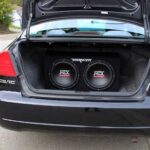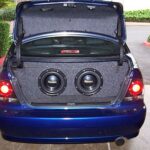So, if you are confused about how to connect subwoofer to the amp without sub out, don’t worry. In this article, I’ll show you how to make a connection without the subwoofer output on your amp as well as details about when and how to use it.
I’m going to break down some common issues that come up with making connections between amps and speakers so we can go through them one by one.
First of all, if you are not using an external speaker for either the amplifier or receiver (since they’re in different rooms) then connecting your wire from one amp/receiver is easy: just connect wires! The key here is whether or not both amplifiers have the same power rating – if they do then just hook up red+red=yellow+black to yellow and black and you’re good to go.
If you have any confusion, the power rating is indicated by how many watts per channel it can do: for example, an amplifier with a 500-watt power output would be labeled as “500w”. Both of your amps must be rated at the same or higher level so they don’t blow out.
The next setup involves running two different sets of speakers but still on one amp – this process takes more time because there are more connections required to make everything work! The first step is getting another red+red wire-like before; then connect black from the second subwoofer (or speaker) to either terminal marked Input Left/Right (it doesn’t matter which).
-Connect black from the first subwoofer to either terminal marked Input Left/Right (again, it doesn’t matter which). The last step is connecting a red wire between the two sets of speakers.
– Red+Red Wire – Connect Black from Second Subwoofer to Either Terminal Marked Input Left/Right (It Doesn’t Matter Which)
– Connect Black from First Subwoofer to Either Terminal Marked Input Left/Right (Again It Doesn’t Matter Which)
– Connect A Red Wire Between Two Sets of Speakers
The next setup involves running two different sets of speakers but still on one amp and this process takes more time because there are more connections required to make everything work!
Start by connecting the two sets of speakers. To do this, run a wire from one set to another and connect them with an input connector (usually color-coded). The next step is to connect the amp’s outputs to both sets of speakers. Run black wires between terminals marked Input Left/Right on your amplifier, then attach these wires in some fashion to each speaker set.
Connect One Set of Speakers with Another by Running Wire from One Speaker Set and Connect It with An Input Connector (Usually Color Coded)
-The Next Step Is to Connect Your Amp’s Outputs to Both Sets of Speakers; Run Black Wires Between Terminals Marked “Input” On Your Amplifier, Then Attach These Wires in Some Fashion to Each Speaker Set.
-After That, Connect One End of The Wire from Your Subwoofer (usually Red) Into the Input Left on Your Amp
-Connect An Output Lead from This Same Terminal to Whatever You Want as A Source: TV, DVD Player, etc.
-Now Run Another Length of Wire–Usually Blue–To the Other Set’s Right Speakers And Again Connect It With An Audio Output Plug; Finally Touch Up All Splices With Electrical Tape or Insulating Gel If Necessary For Safety!
-Then Connect The Left Set Of Speakers To Your Right Output Plug On Your Amp
-Now Connect Up Your Subwoofer And Play Music!
Step by step process (h2)
Step One: (h3)
Determine where you want your subwoofer to sit about the speakers. If it is behind them, place it as close as possible and make sure there’s a clear path for sound waves that will travel from one speaker to the other.
Step Two: (h3)
Run audio wire between all of your equipment so they’re connected properly (usually color-coded) or purchase an RCA cable with male ends on each end if you don’t have enough inputs available.
Step Three: (h3)
Remember that when at least part of your system includes a surround sound receiver, this step can involve running an audio wire from the subwoofer to a set of inputs on your receiver. If you have an amplifier that has pre-amp outputs, then connect them up as well and run the speaker wire between the two.
Step Four: (h3)
Connect power cables for all components and make sure all switches/buttons are in their off position before plugging any cable into another component or outlet
Step Five: (h3)
Test! Make sure everything is working properly by listening to some music with both high and low frequencies involved. You should be able to feel the bass coming from your speakers without much distortion if they’re positioned correctly
Most people don’t realize how important it is to choose where you want the placement of your subwoofer before slapping one in the corner of your living room. It might be hard to believe, but where you place a subwoofer can have a big effect on how well it performs and how much bass you’ll feel when listening. If noise is an issue for those around you, then there are some things to take into consideration before deciding to put one in their home:
– If more than just yourself will be using this space with the subwoofer, placement should not only consider what’s best for sound quality but also how noisy that location happens to be (for instance; if someone is sleeping nearby). Try placing it on your floor instead of up against or near any walls since they could end up being louder due to bouncing off surfaces. Ceiling or high wall placement could also work but the speaker might not be as effective.
– If you’re placing it in a living room, don’t place it too close to your TV or any other device that emits electromagnetic waves since this can create distortion and buzzing sounds. Keep at least three feet away from those types of electronics for best results.
– You’ll want to use heavy objects like furniture such as bookshelves, couches, and large armoires to help reflect sound into space rather than allowing them to escape outwards where they will bounce off walls creating more noise. This is especially important if there are open windows nearby which would allow outside noises inside easily without some form of acoustical treatment.
– For those who are getting a subwoofer, there should be some type of adapter that comes with it to allow you to plug it into the amp.
– You may also have an auxiliary input which will work as well.
– If your speakers only come with two cables (one for power and one for audio), then you’ll need to purchase a third cable to connect them. The next step is just connecting all three cables before running them through whichever back channels on your receiver that are available. For example, if they’re in the center channel speaker outputs, then run these wires from either right or left side output terminals on your receiver and finally touch up by using wire nuts were needed since soldering might not always look great when finished.
– The next step is just connecting all three cables before running them through whichever back channels on your receiver that are available. For example, if they’re in the center channel speaker outputs, then run these wires from either right or left side output terminals on your receiver and finally touch up by using wire nuts were needed since soldering might not always look great when finished
– You will have a subwoofer out jack which you’ll need to connect with an RCA cable into the Sub Out input of your amplifier
– Don’t forget to switch off “subwoofer + low pass filter” at the rear panel so we can hear normal bass frequencies coming from our second active speaker! If this option wasn’t switched off already after plugging in our active speakers
– Connect the power cord of your subwoofer to a nearby power outlet.
– Now you will be able to hear bass frequencies coming from both speakers! At this point, some people may listen to it and decide they want more – or less – low end than what is being sent out by their amp’s preamp signal. If that sounds like you, then there are additional options for customizing how much bass energy each speaker hears via the crossover menu on your amplifier (or receiver)
– e.g., if we wanted a high pass filter of 80 Hz with an 18 dB per octave slope to protect one set of tweeters when using two subs instead of just one…we would select 80 Hz from the crossover menu and then set 18dB per octave to achieve it.
– This will remove all frequencies above 80Hz which are not wanted by our speakers while keeping them there for our subwoofer. The result is that you’ll get more lows from your system than otherwise possible.
Below is a complete list of ways how to connect subwoofer to amp without sub out:
– Connecting one speaker wire between your amplifier’s LFE (low-frequency effect) output jack and the input on your powered subwoofer’s low pass filter/output jack or terminal marked “sub-out”
– Connecting both speaker wires between your amplifier’s mono outputs jacks and one of the speaker terminals on your powered subwoofer
– Connecting both speaker wires between a mono preamplifier’s left and right input jacks and connecting them to an amplifier out jack marked “sub” or “low-frequency effect.” The amplifier would then be connected to a speaker wire from its output amp terminal, which is usually labeled “high level in,” to the powered subwoofer’s low pass filter/output jack or terminal marked “sub out.”
– Using a signal splitter (sometimes called Y adapter) that has two female RCA plugs on it; one for LFE input, and another for stereo inputs. This makes it possible to connect multiple amplifiers with separate outputs to a single subwoofer without having to use the “sub-out” connection.
– Connecting both speaker wires between one input jack and an output amp terminal labeled “low level in,” usually found on amplifiers with stereo inputs or outputs.
This is done by connecting them using either of two methods: (h2)
Method One: (h3)
Using a T-coupler that has left/right RCA plugs on it; connect one plug to your amplifier’s low-frequency effect (LFE) input, then take the other LFE plug and split it into two female RCA plugs for connections from each side of your subwoofer’s line cord tapped down at the same point as close to its power supply wire coming up through its base.
Method Two: (h3)
Using a T-coupler with RCA plugs on it to connect your subwoofer’s low-frequency effect (LFE) input, then take the other LFE plug and split it into two female RCA plugs for connections from each side of your amplifier’s line cord tapped down at the same point as close to its power supply wire coming up through its base.
– To do this without wiring anything in parallel or series, you need to use Y adapter cables that have left/right male RCA connectors on one end and an “in” jack on the other where you can hook them up like any normal cable audio connection: Left – Right + Ground = good sound!
– For amplifier connections using this method, you can’t use a standard RCA-to-RCA cable because the “in” jack is missing — instead, you need to get an audio Y adapter with male RCAs on one end and female RCAs on the other.
Final Thought (h2)
There you have it, how to connect a subwoofer without having access to the SUB OUT on your amplifier. You should now be good and ready for all those sweet bass beats that will come through loud and clear with this new setup – if not already then soon enough!






